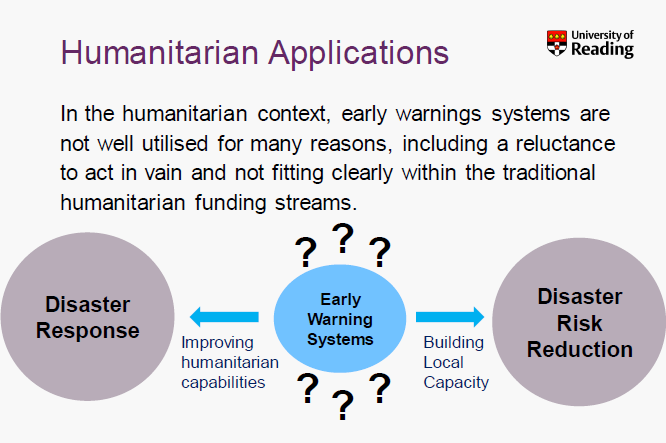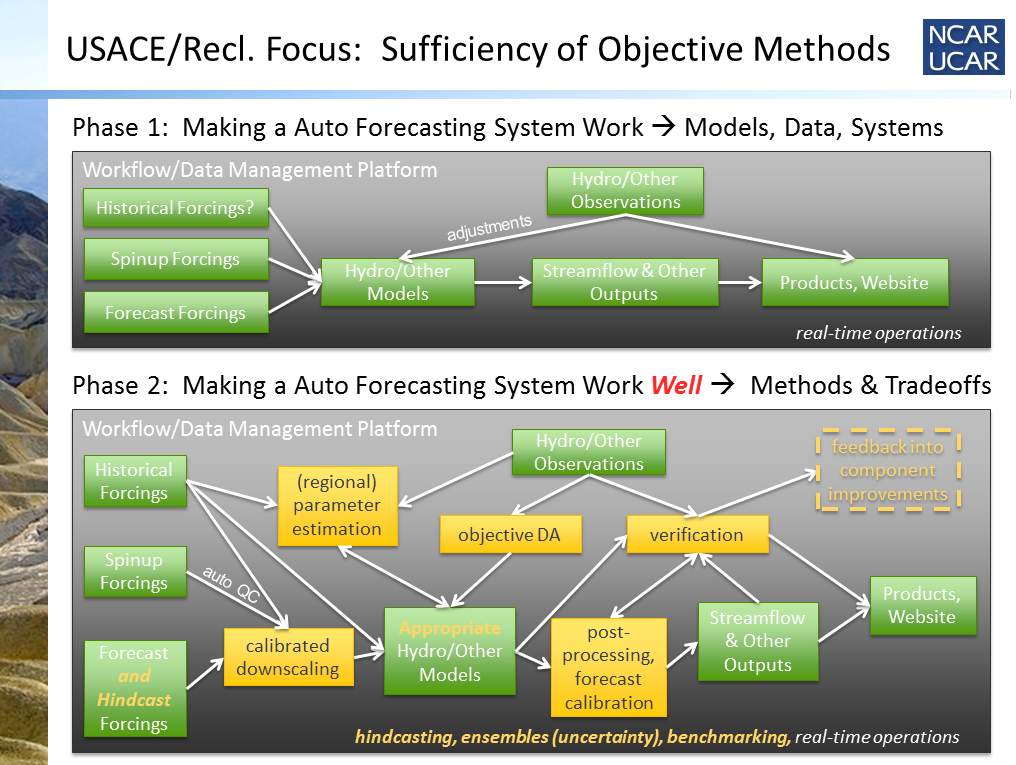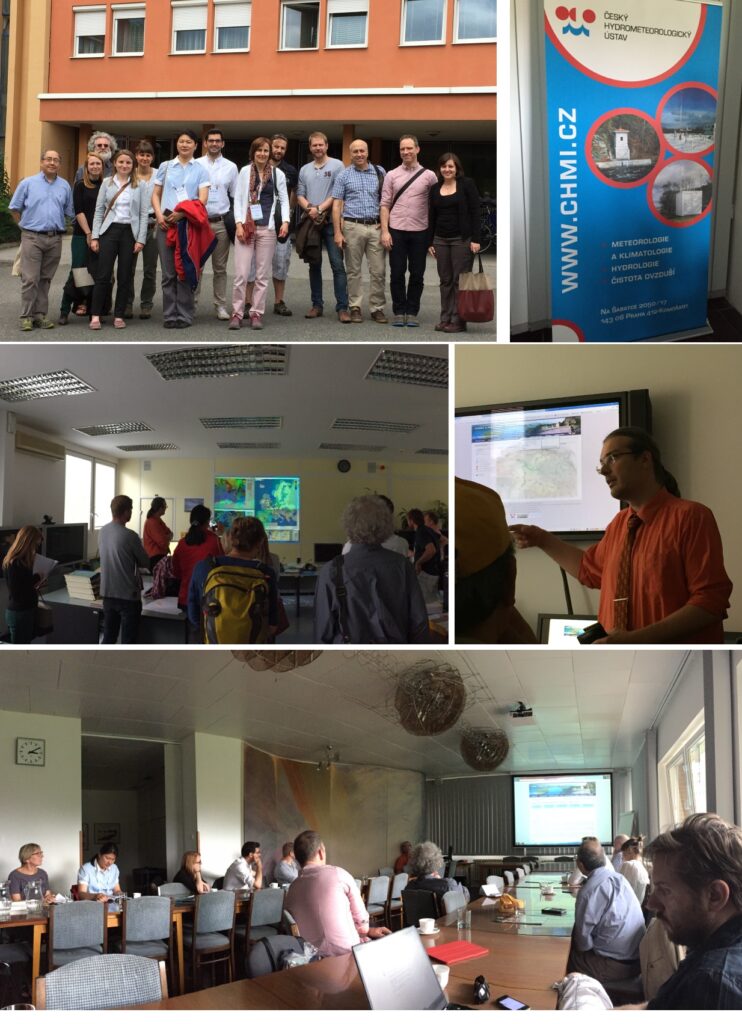From research to operations and vice versa: feedback from the HEPEX session at IUGG/IAHS workshop
Contributed by Maria-Helena Ramos, Fredrik Wetterhall and Andy Wood
A Sunday in Prague can be spent in the tourist crowds on the main square, a leisurely stroll over the Charles bridge up to the castle to enjoy the stunning views, or it can be spent in at a conference centre attending “Hydrological Forecasting and Predictive Uncertainty: Advances and Challenges of Transferring Science into Operational Practice”. That was the title of the session at the IUGG General assembly/IAHS workshop that was held in Prague on June 28th, organized and attended by an enthusiastic cadre of HEPEX members from around the world.
Hydrological Forecasting oral session at IUGG/IAHS Workshop in Prague, 28 June 2015
A full day of oral and poster presentations covered topics such as data assimilation, pre/post-processing, operational ensemble prediction systems, global forecasting, and emergency response to extreme events (see the program here: IUGG-HW17-Programme ).
The poster session was a great opportunity to connect with people and exchange ideas. Posters had a clear focus on challenges for the development of operational systems and uncertainty quantification approaches that can be easily implemented in real-time forecasting.
Also, the session was live-tweeted throughout the day to #hepex, creating a fabulous social media activity. Many thanks to everyone who helped to make it happen!
Hydrological forecasting poster session at IUGG/IAHS Workshop in Prague, 28 June 2015
Main topics discussed
It is hard to summarize all the discussions we had in Prague, but a number of take-away messages drew our attention:
- Incorporating data assimilation and post-processing techniques in operational forecasting systems is still a challenge and a potential opportunity to enrich research on improving forecast quality and system’s performance. Bayesian methods, copula -based modelling, ensemble Kalman filter, variational data assimilation… a wealth of approaches to pre/post-processing hydrometeorological forecasts reveal how rich this topic has become in hydrological prediction.
- Ensemble forecasting applications are diverse, from flash flood alert to avalanche hazard assessment and inundation risk mapping. Current needs on multi-hazard and multi-risk assessment can be seen as a call for more interdisciplinary and collaborative research programs.
- Global hydrological forecasting systems have been developed in the last years to provide an overview on predictions and upcoming flood events with global coverage, and thus support national agencies and humanitarian organizations in their actions. Work to refine their concepts, model calibration and forecast verification raise several issues. Data gaps, for instance, are critical in several areas and improving data collection and accessibility may require more investment in data sharing and associated web services. Additionally, using different global data sets (eg, different meteorological reanalyses) to calibrate a system can have an impact on the assessment of flood alert thresholds and on the evaluation of forecast skill against observed events.
- The choice for a fit-for-purpose forecasting system may rely on the analysis of how decision makers receive (or would like to receive) and use flood forecasts. This means that the process of developing and implementing a framework for flood forecasting can gain from a collaborative approach, where consultative workshops can help in co-deciding on thresholds, triggers for actions or variables for targeted verification.
Slide from Liz Stephens’ presentation: “User-defined development priorities for global scale flood forecasting”. The full presentation is available here.
- Sub-seasonal to seasonal flow forecasting is also a topic that increasingly draws the attention of the HEPEX community. How to extend predictability, quantify the influence of initial conditions vs skill from the forecast, take advantage from monthly forecasts, or integrate model outputs with management practices from users of specific hydrological applications are some of the many objectives of scientists and practitioners working in this field. This emerging topic concerns a variety of applications and users. For instance, a lecture from Dr. Christopher White, University of Tasmania, given on June 24th during the session HS01, Changes in Flood Risk and Perception in Catchments and Cities, showed how risk awareness and preparedness can be enhanced with S2S ‘Subseasonal-to-seasonal’ hydrometeorological forecasts. His work can be found in the IAHS Proceedings (here). Perfect timing thus for the upcoming Hepex workshop in Norrköping, Sweden, this September! (please contact the organizers if interested in attending or presenting).
From research to operations and vice versa
An overarching goal of this session, the upcoming workshop, and other HEPEX activities is to contribute to (or launch) community-wide discussions on the research to operation (or applications) loop in hydrological forecasting: how to feed operational hydrology with research achievements in ensemble prediction, and vice versa, how to effectively bring practice into research programs for enhanced approaches?
Several studies and years of experience suggest that it is important to assess alternatives in the river flow forecasting process before putting new methods and approaches in practice. It is likely not enough simply to wire together data streams and models and hope that they will provide high quality outputs due to their physics or resolution. A range of supporting methods (e.g., pre/post-processing) can help to ensure that outputs are reliable, and real-time, automated testbed systems can help the community to demonstrate and evaluate these methods (which HEPEX highlights as research challenges).
Making such frameworks available for both scientists and practitioners can facilitate investigation into how methods developed in a research context work in practice. They can also contribute to enhance interactions with decision-makers and between modellers and forecasters, and the dissemination of forecast results can help raise awareness about ensemble forecasting and predictive uncertainty and, therefore, should be highly encouraged.
Slide from Andy Wood’s presentation: “A real-time, automated demonstration and evaluation of short to seasonal range streamflow forecasting in US watersheds”.
A day out to the Czech Hydrometeorological Institute
A real highlight of the hydrological forecasting gathering during the IUGG/IAHS conference was a visit to the Czech Hydrometeorological Institute (CHMI). Jan Danhelka, the CHMI chief hydrologist (and also a very active member of the EFAS community and a HEPEX Columnist), was a gracious host, showing the group the hydrometeorological forecast products for the Czech Republic and offering a candid discussion of challenges and opportunities found in building modern hydrometeorological services.
HEPEX members visit the Czech Hydrometeorological Institute in Prague
The publicly available meteo-hydrological forecasts are currently deterministic, but CHMI have starting experimental developments of ensemble forecasts, including monthly forecasts, to produce probabilistic hydrological outlooks for the Czech Republic.
We also learned about the long history of the Hydrological service in Bohemia, which is celebrating 140 years of continuous services (established in June 1875, it is probably the 4th oldest in the world). We saw posters and photos of past flood events in Prague and were introduced to the ‘Bearded man’, a water gauge in Prague since 1481!
Many thanks to Jan Danhelka and CHMI personnel for their hospitality!
Pictures of posters from the Czech Hydrometeorological Institute in Prague






0 comments